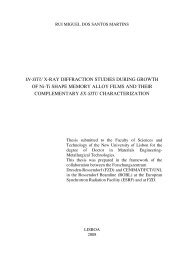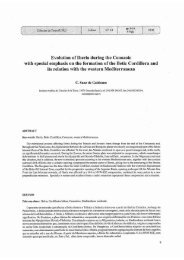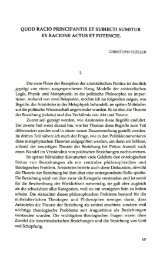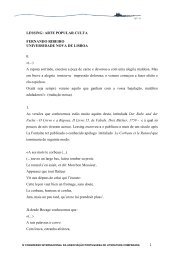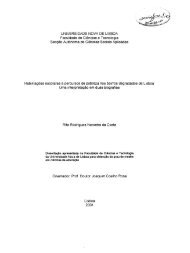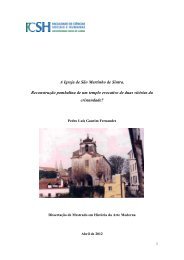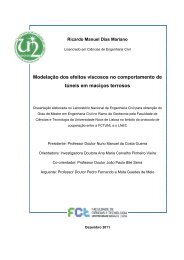Elias Manuel Morgado Pinheiro Dissertação de Mestrado em ...
Elias Manuel Morgado Pinheiro Dissertação de Mestrado em ...
Elias Manuel Morgado Pinheiro Dissertação de Mestrado em ...
You also want an ePaper? Increase the reach of your titles
YUMPU automatically turns print PDFs into web optimized ePapers that Google loves.
A second type of chariot was used at the time, named the “Hittite Chariot” or<br />
“Anatolian Type Chariot” 24 . Unlike the Egyptians, the Hittites did not use the chariot<br />
exclusively as a firing platform, also using it to fight at close quarters. Therefore, their<br />
chariots were of heavier build, having a fully filled riding, probably with leather or<br />
wood, in or<strong>de</strong>r to protect the crew. Since the “hittite chariot” wasn‟t used to fire<br />
projectiles at the en<strong>em</strong>y, it did not require the ad<strong>de</strong>d stability, and therefore maintained<br />
the axle centred beneath the box. On the other hand, chariots with their axles placed at<br />
the rear of the box significantly increased the pressure on the horses‟ necks; while this<br />
increased pressure might have been tolerable on light-rail chariots, it might not be the<br />
case on these heavier types. Nevertheless, there are <strong>de</strong>pictions of the Hittite chariot<br />
being used as a fire platform. The shift to close-quarter battle is a later <strong>de</strong>velopment, as<br />
early chariots from the heart of the <strong>em</strong>pire were <strong>de</strong>picted with a driver and a bowman.<br />
The heavy Hittite chariots‟ cab had approximately 1.25m width by 1m <strong>de</strong>ep, in<br />
or<strong>de</strong>r to accommodate the third crewman. The riding of the cab was built out of wood<br />
slats, covering all si<strong>de</strong>s but the rear. The standard wheels show six spokes, being c.<br />
90cm in diameter. The draught pole runs un<strong>de</strong>r the cab, all the way to the rear, for ad<strong>de</strong>d<br />
strength.<br />
Besi<strong>de</strong>s the driver, the Hittite chariot carried a spearman, whose mission was to<br />
thrust a spear, not hurl it, into the en<strong>em</strong>y, as well as a shield-bearer, protecting the other<br />
two (fig. 7). The latter is sometimes <strong>de</strong>picted carrying throwing spears. However, early<br />
examples of Hittite chariots are seen carrying a driver and an archer, armed with a<br />
composite bow, in similar fashion to the Egyptian ones. The Hittite chariot warriors<br />
wore heavy scale armour, covering most of their bodies, and bronze helmets, while the<br />
driver and the shield-bearer wore light textile armour. 25 It has been suggested by<br />
Littauer and Crouwel 26 that both <strong>de</strong>signs are resultant of the evolution of previous cars<br />
found either in Anatolia or in the Near East, hence being a local <strong>de</strong>velopment.<br />
According to th<strong>em</strong>, the light chariot had its origins “either as a flat car with open railing<br />
(Anatolia), as a shallow open-railed vehicle with curving pole (Mesopotamia), or<br />
(Syria) as a gradual modification of the old platform car”. 27<br />
24 It should be noted that “Hittite Chariot” or “Anatolian Type Chariot” are a specific type of chariot and<br />
do not represent the entirety of the chariots used by Hittites. They <strong>de</strong>ployed many different types of<br />
chariots, reflecting the many nations un<strong>de</strong>r their control.<br />
25 Fields, 2006, pp.19-20<br />
26 Littauer and Crouwel, 1980<br />
27 Littauer and Crouwel ,1980, §3<br />
18







